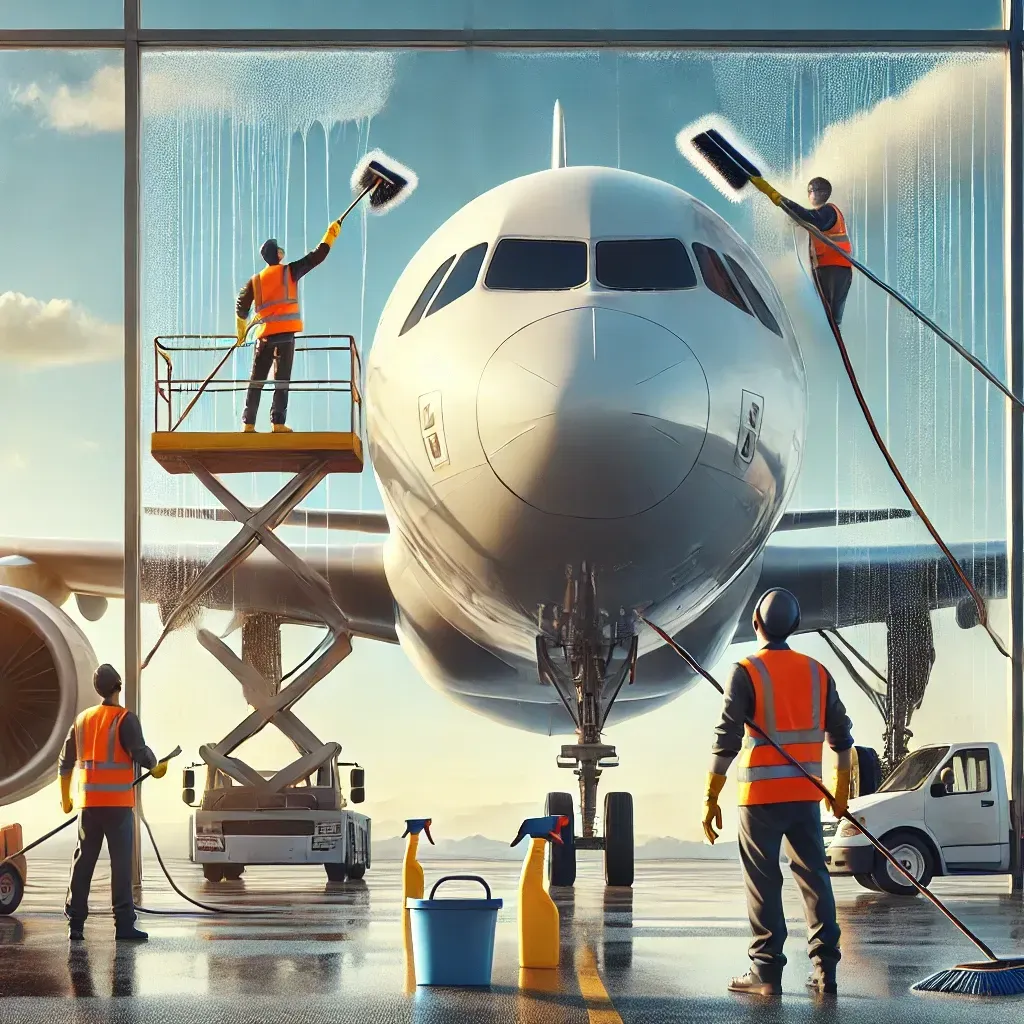
How Frequently Are Airplane Windows Cleaned?
Airplane windows endure extreme conditions, from high-altitude grime buildup to the impact of rapid temperature changes. While cockpit windows are cleaned regularly for safety, passenger windows require less frequent maintenance. Airlines follow strict exterior maintenance protocols, but the frequency of cleaning depends on factors such as weather, flight routes, and operational requirements. In this article, we’ll explore how often aircraft windows are cleaned, the techniques used, and why proper window maintenance is essential for both visibility and passenger experience.
The Importance of Keeping Airplane Windows Clean
Aircraft windows are more than just a portal to the skies. They are a crucial part of flight safety, passenger comfort, and overall aircraft maintenance. A clean windshield ensures pilots have unobstructed visibility, which is critical for safe navigation. Meanwhile, the cleanliness of passenger windows impacts the overall travel experience, preventing fogging and ensuring a clear view.
Factors Affecting Cleaning Frequency
Several factors determine how often airline cleaning procedures include window maintenance:
Flight Frequency: High-traffic aircraft may undergo more frequent cleaning.
Weather Conditions: Rain, snow, and dust storms increase the need for windshield maintenance.
Bug Removal: Flights over areas with high insect populations require more regular cleaning.
De-Icing System Residue: Chemicals used for de-icing can leave a hazy residue that needs to be removed.
FAA Regulations on Window Cleaning: Some cleaning procedures are mandated by aviation authorities to ensure safety.
How Cockpit Windows Are Maintained
The cockpit windows undergo the most rigorous cleaning since they play a direct role in windshield visibility. Pilots rely on a clear view for takeoff, landing, and in-flight navigation.
Airline maintenance crews use specialized non-abrasive cloths and microfiber cleaning techniques to avoid scratches on the plexiglass. Unlike traditional glass, airplane windows are made of multiple layers of plexiglass and laminate, making them susceptible to hazing if cleaned improperly.
"All cleaning motions follow the airflow direction to prevent fine scratches that could impair visibility over time."
Cleaning Methods Used for Cockpit Windows
Water and Hand Rinse: The safest initial method, preventing dust and debris from scratching the surface.
Chemical Cleaning Solutions: Formulated for aircraft glass, these solutions remove stubborn grime without damaging coatings.
Microfiber Cloths: Used to dry windows and eliminate water spots.
UV Protection Treatments: Prevents UV exposure damage that can degrade the materials over time.
For commercial aircraft operating multiple flights per day, cockpit windows may be cleaned between flights, while private and general aviation aircraft might have a less frequent schedule.
Passenger Windows: Do They Require Regular Cleaning?
Unlike cockpit windows, passenger windows are not exposed to the same level of dirt, bugs, and debris. Since they are positioned along the fuselage rather than facing directly into the airflow, they accumulate less grime. However, they are still subject to passenger window fogging, fingerprints, and general wear over time.
How Often Are Passenger Windows Cleaned?
Airlines do not typically clean passenger windows between every flight. Instead, window cleaning is often included in scheduled cleaning routines that occur during deeper aircraft maintenance cycles.
Daily Spot Cleaning: Cabin crew may wipe down windows as part of quick turnaround maintenance.
Regular Deep Cleaning: During scheduled aircraft detailing, passenger windows are cleaned using non-abrasive cloths and specialized solutions.
Major Overhauls: During extensive maintenance checks, windows are inspected for scratches, damage, and UV exposure damage that may cause material degradation.
Although passenger window cleaning is less frequent, maintaining clear windows contributes to an enjoyable flying experience. For airlines that emphasize premium passenger comfort, window cleaning may be included in more frequent maintenance cycles.
Challenges in Aircraft Window Cleaning
Keeping airplane windows clean is not as simple as washing a car windshield. The aviation industry faces several unique challenges when it comes to maintaining clear and scratch-free plexiglass.
1. High-Altitude Grime Buildup
Flying at high altitudes exposes aircraft windows to dirt, pollution, and atmospheric particles, which can gradually cloud visibility.
2. Bird Strike Residue Removal
Cockpit windows sometimes suffer from bird strikes, which leave debris and stains that require specialized cleaning techniques.
3. Hazing Prevention
Over time, small scratches from improper cleaning can lead to a hazy appearance. This is why microfiber cleaning and airflow direction cleaning are essential.
4. Chemical Sensitivity
Unlike standard glass, plexiglass cleaning requires careful selection of cleaning agents to prevent damage. Harsh chemicals can weaken window integrity over time.
For airlines looking to maintain their fleet at the highest standard, professional aircraft detailing services are often employed to handle complex cleaning requirements.
How Airlines Ensure Long-Term Window Maintenance
While regular cleaning keeps airplane windows in good condition, long-term maintenance is just as important. Airlines follow strict aircraft hygiene standards, ensuring that both cockpit and passenger windows remain clear, scratch-free, and structurally sound.
Scheduled Window Inspections
Beyond routine cleaning, aircraft windows undergo scheduled maintenance checks to assess for damage, wear, or necessary replacements. These inspections help prevent UV exposure damage, ensure structural integrity, and maintain compliance with FAA regulations on window cleaning.
Common Maintenance Practices Include:
Visual Inspections: Checking for scratches, cracks, or clouding that could impact visibility.
Protective Coatings: Applying anti-scratch and anti-UV coatings to extend the lifespan of windows.
Replacement of Damaged Windows: If a window is severely scratched or weakened, it is replaced to maintain safety standards.
While passenger windows rarely require full replacement, cockpit windshields endure greater stress and may need periodic upgrades.
The Role of Professional Aircraft Detailing Services
To ensure the highest cleaning standards, many airlines rely on aircraft detailing services that specialize in exterior maintenance. These professionals use chemical cleaning solutions specifically designed for aviation glass, ensuring that both cockpit and passenger windows remain crystal clear.
Benefits of Professional Aircraft Window Cleaning
Prevents scratches and hazing by using specialized techniques and non-abrasive cloths.
Enhances aerodynamic efficiency by maintaining a smooth, clean surface.
Improves passenger experience by keeping windows free from streaks and fogging.
For smaller aviation companies or private aircraft owners, outsourcing to detailing specialists is a cost-effective way to maintain cleanliness and safety.
Final Thoughts
Although passengers may not always notice, airplane windows undergo regular cleaning and maintenance to ensure flight safety, passenger comfort, and regulatory compliance. Cockpit windshields receive the most attention due to their direct impact on navigation, while passenger windows are cleaned at scheduled intervals as part of routine exterior maintenance.
For airlines and aircraft operators, ensuring proper window cleaning procedures is just one part of maintaining a high-quality fleet. From bug removal to high-altitude grime buildup, every aspect of window maintenance plays a role in delivering a safe and enjoyable flight experience.
Get Professional Window Cleaning Services
If you're looking for professional window cleaning solutions, Pivotal Window Cleaning offers expert services across the UK. Whether it’s for commercial buildings, aviation, or high-rise properties, our team ensures spotless, streak-free results.
For service availability in your area, visit our locations page or request a quote today.
Frequently Asked Questions (FAQ)
Here are some of the most commonly asked questions about how often airplane windows are cleaned and what goes into maintaining them.
1. Are airplane windows cleaned between every flight?
Not always. Cockpit windows are cleaned more frequently than passenger windows, especially if visibility is affected. However, full window cleaning is typically part of scheduled cleaning routines rather than a post-flight requirement.
2. What cleaning products are used on airplane windows?
Airlines use chemical cleaning solutions designed for aviation glass. These solutions are formulated to remove grime without damaging the plexiglass layers. Non-abrasive cloths and microfiber cleaning techniques are used to prevent scratches.
3. How do airlines prevent windows from becoming scratched during cleaning?
Cleaning motions follow the airflow direction to avoid micro-scratches that could cause hazing over time. Abrasive materials are avoided, and microfiber cloths or specialized cleaning sponges are used instead.
4. Do airlines ever replace passenger windows?
Passenger windows are rarely replaced unless they develop cracks, delamination, or UV exposure damage over time. They are inspected regularly as part of aircraft maintenance protocols.
5. How do pilots clean cockpit windows mid-flight if they get dirty?
Cockpit windows have windshield wipers for rain and a de-icing system to remove ice buildup. However, if dirt or insect residue obstructs visibility, pilots must wait until landing for external cleaning.
6. What happens if an airplane window gets extremely dirty during flight?
For cockpit windows, poor visibility could impact safety, so exterior maintenance teams clean them thoroughly on the ground. Passenger windows, however, do not affect flight performance and are only cleaned when necessary.
7. Can passengers clean their own windows during a flight?
Passengers cannot clean the outside of their windows, but they can use a napkin or cloth to wipe the inside if needed. However, touching the window too often may contribute to passenger window fogging.
8. Are airplane windows cleaned differently in extreme weather conditions?
Yes. In snowy or icy conditions, de-icing solutions may be used on cockpit windshields, and in tropical climates, more frequent bug removal is necessary. Airlines adapt cleaning methods based on environmental factors.
9. Does a cleaner window improve the aerodynamic performance of the aircraft?
While clean cockpit windshields improve windshield visibility, passenger windows have little to no effect on aerodynamics. However, a clean aircraft exterior—including windows—can contribute to reduced drag.
10. How can I ensure my commercial or private aircraft windows stay clean?
Regular aircraft detailing services can keep windows in top condition. Many aviation professionals rely on specialized cleaners to remove dirt, prevent high-altitude grime buildup, and maintain overall aircraft aesthetics.
